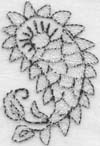Section 9 == *script chart*; *positional chart*; *more help*
The letter nūn-e ġhunnah is the nasalizer in Urduu; ġhunnah literally means "talking through the nose." It is basically just a slightly modified form of nūn , "n." This special modified form occurs only in word-final position, and only after the long vowels alif , vāʾo , chhoṭī ye , or baṛī ye . In that position, it looks just the way nūn in final position would look, except that the dot is missing.
In many Persian-derived words this word-final nasalization can come and go, which is very convenient for poets since it gives them leeway in scansion: one can write either zamīn or zamīñ (land), either ḳhān or ḳhāñ (Khan). But before an iẓāfat (see section 5.4), nūn-e ġhunnah must revert to an ordinary nūn : zabāñ (language) must become zabān-e urdū (the Urdu language).
EXCEPT under these special word-final post-long-vowel conditions, nūn-e ġhunnah looks just the same as an ordinary nūn , and must be deduced by (what else?) knowing the word. It is possible for the difference to be shown in the script, by means of the nasalizer diacritic (see below, section 9.2). But this diacritic appears rarely enough so that in fact it's not much help at all. Normally you would see a word like jīm + nūn + gāf + lām , quite devoid of diacritics, and only prior knowledge could tell you that it was jañgal rather than, say, janagal (not to mention jiñgal , ,jañgul , jinugal , etc. etc., through all the other possible permutations). This is what you're learning the script for, after all: to use your fine mind to the fullest.
In metrical terms, nūn-e ġhunnah is invisible, and doesn't count as a letter at all. For discussion of the metrical system used in classical Urdu poetry see *Urdu Meter: a Practical Handbook*.
The nasalizer diacritic looks like a small semicircle with the open side usually pointing upward. It is placed only above a medial form of nūn , or an initial form of nūn that is located within a word (i.e., after a non-connector). It shows that the nūn in question is a nasalizer rather than a full nūn : it tells you, for example, that sīn + alif + nūn + pe (snake) is sāñp rather than, say, sānap .
In Devanagari script there's a kind of overlapping in practice between nasalization and half-forms of "na": thus "Hindi" can be written either with a nasal dot above the short i, or with a half-"na" grafted on in front of the "da" The condition, however, is that the half-"n" form must be from the same row in the alphabet chart. Thus when it comes to the row "pa pha ba bha ma," the appropriate half-"n" form turns out to be half of a "ma." Therefore the word lambā (long, tall) can be written either with a nasal dot over the "la" or (more commonly) with a half-"ma" grafted on in front of the "ba."
In Urdu, the same phonetic rules obtain: the word guñbad (dome), even if it does not have the nasalizer diacritic over the nūn , is in practice pronounced "gumbad." There is an expensive perfume spelled ʿanbar and pronounced (even without the nasalizer diacritic) like ʿambar .
On the whole, nasalization is
easier to deal with in Urdu than in Devanagari, because
it's simple and sweeping, and isn't divided up into
various kinds of subsets. It's one of the two main
things that Urdu script does more conveniently and
efficiently than Devanagari; the other, even more
notably, is aspiration, discussed in section 10.
Nasalization may strike you as awkward or uncomfortable-sounding when you're learning. But actually it's pretty easy to achieve. To practice, start to say a prolonged version of whichever long vowel you need, and then pinch your nose shut halfway through and keep producing the same sound. The result is a drastically nasalized vowel. Once you can learn to feel and recognize the sound back in your sinuses, you can easily manage to produce it without such draconian measures.
And produce it you must. Probably you've noticed that, among many other uses, it's the only difference between "is" [hai] and "are" [haiñ]. People will count on you to provide them with that basic information, so they can understand you when you speak. The diphthong vowel sound of hai may fluctuate regionally, and everybody can easily deal with that; but the nasalization must be properly controlled. Start working on it carefully from the earliest stage of your learning, and just get it right. You'll be glad you did. (This message brought to you by the Voice of Experience.)
